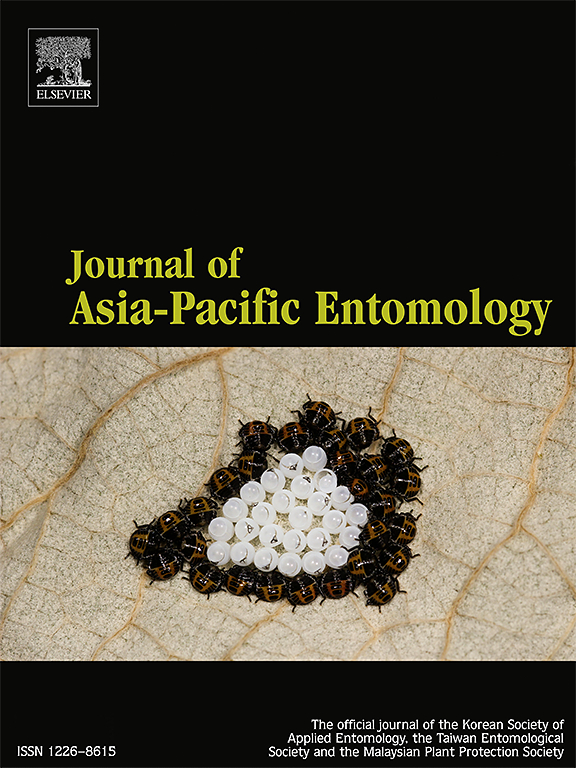Virulence of Beauveria bassiana ARP14 on two ladybird beetles: Harmonia axyridis and Chilocorus sp.
IF 1.3
3区 农林科学
Q3 ENTOMOLOGY
引用次数: 0
Abstract
Ladybird beetles are common predators that help reduce populations of many pest insects. In this study, we compared the virulence of a native entomopathogenic fungus, Beauveria bassiana ARP14, with a commercial strain (GHA) of the same species to two ladybird beetles, Harmonia axyridis and Chilocorus sp. The pathogen was applied via topical application in the laboratory at 1 × 108 conidia/ml. The ST50 values were not different between the ARP14 and GHA strains for larval H. axyridis, but were higher for the ARP14 strain for adults of both species. ARP14 showed less virulence against adult ladybird beetles than did GHA. However, the mycosis rates on larval H. axyridis by the ARP14 strain reached 83.3 % at 16 days after treatment, while it was 56.7 % for the GHA strain. Mycosis rates in adults were not different between the ARP14 (up to 56.7 %) and GHA (up to 43.3 %) strains. Chilocorus sp. adults showed higher mycosis rates in ARP14 (up to 80.0 %) than in GHA (up to 46.7 %) for the period from 15 to 20 days after treatment. Therefore, we conclude that B. bassiana ARP14 did not increase ladybird beetle’s mortality, its higher mycosis rate indicates a potential risk to beetles, requiring further study to assess ecological compatibility.

球孢白僵菌ARP14对两种瓢虫的毒力研究。
瓢虫是常见的捕食者,有助于减少许多害虫的数量。在本研究中,我们比较了原生昆虫病原真菌白僵菌(Beauveria bassiana ARP14)与同一种商业菌株(GHA)对瓢虫Harmonia axyridis和Chilocorus sp的毒力。该病原菌在实验室外用,剂量为1 × 108分生孢子/ml。ARP14菌株和GHA菌株对幼虫的ST50值无显著差异,但ARP14菌株对两种成虫的ST50值均较高。ARP14对瓢虫成虫的毒力低于GHA。然而,ARP14菌株在处理16天后对黑僵螺旋体幼虫的霉变率为83.3%,而GHA菌株的霉变率为56.7%。成人真菌发病率在ARP14菌株(高达56.7%)和GHA菌株(高达43.3%)之间没有差异。在治疗后15至20天,ARP14区成虫的霉菌病发病率(高达80.0%)高于GHA区成虫的霉菌病发病率(高达46.7%)。因此,我们认为,B. bassiana ARP14不会增加瓢虫的死亡率,其较高的霉变率表明其对瓢虫有潜在的风险,需要进一步研究以评估其生态相容性。
本文章由计算机程序翻译,如有差异,请以英文原文为准。
求助全文
约1分钟内获得全文
求助全文
来源期刊

Journal of Asia-pacific Entomology
Agricultural and Biological Sciences-Insect Science
CiteScore
2.70
自引率
6.70%
发文量
152
审稿时长
69 days
期刊介绍:
The journal publishes original research papers, review articles and short communications in the basic and applied area concerning insects, mites or other arthropods and nematodes of economic importance in agriculture, forestry, industry, human and animal health, and natural resource and environment management, and is the official journal of the Korean Society of Applied Entomology and the Taiwan Entomological Society.
 求助内容:
求助内容: 应助结果提醒方式:
应助结果提醒方式:


